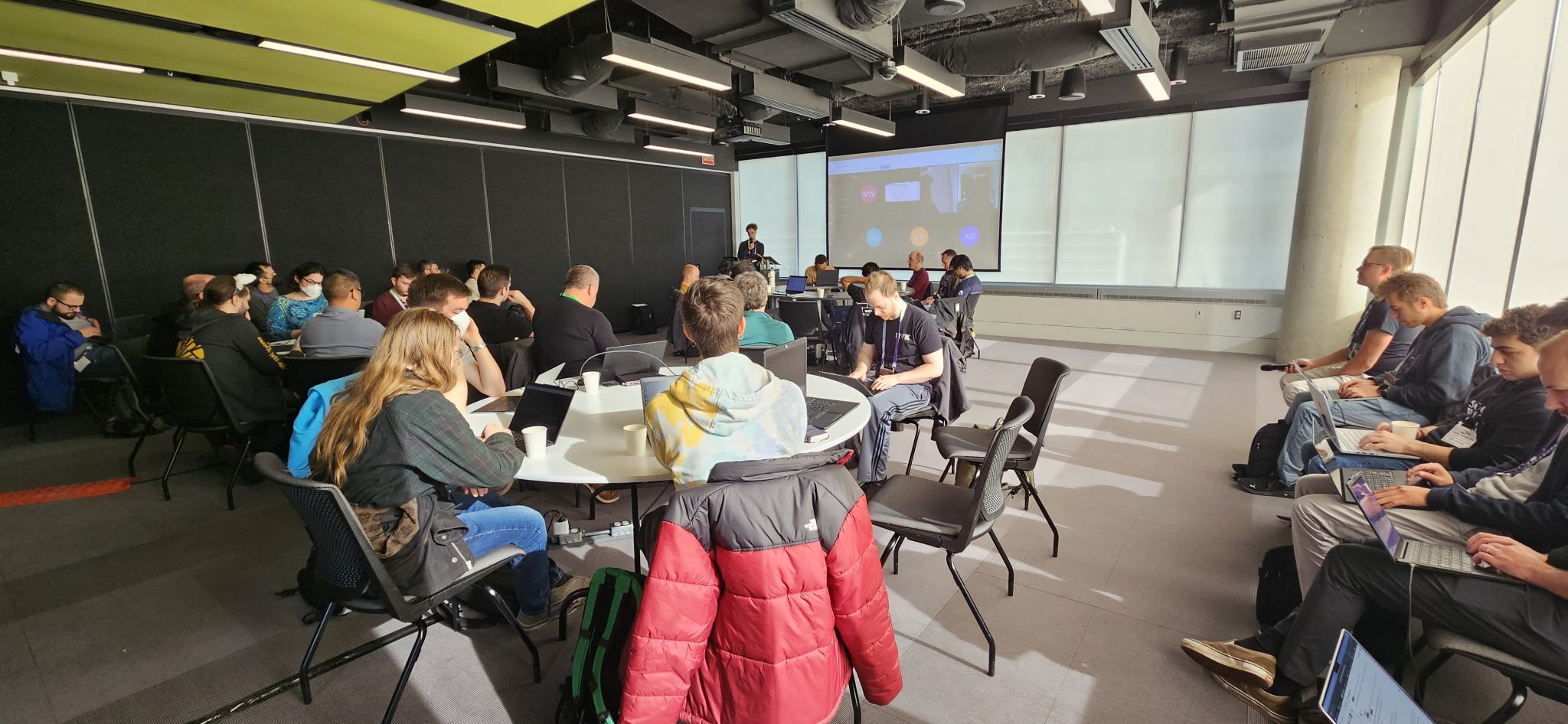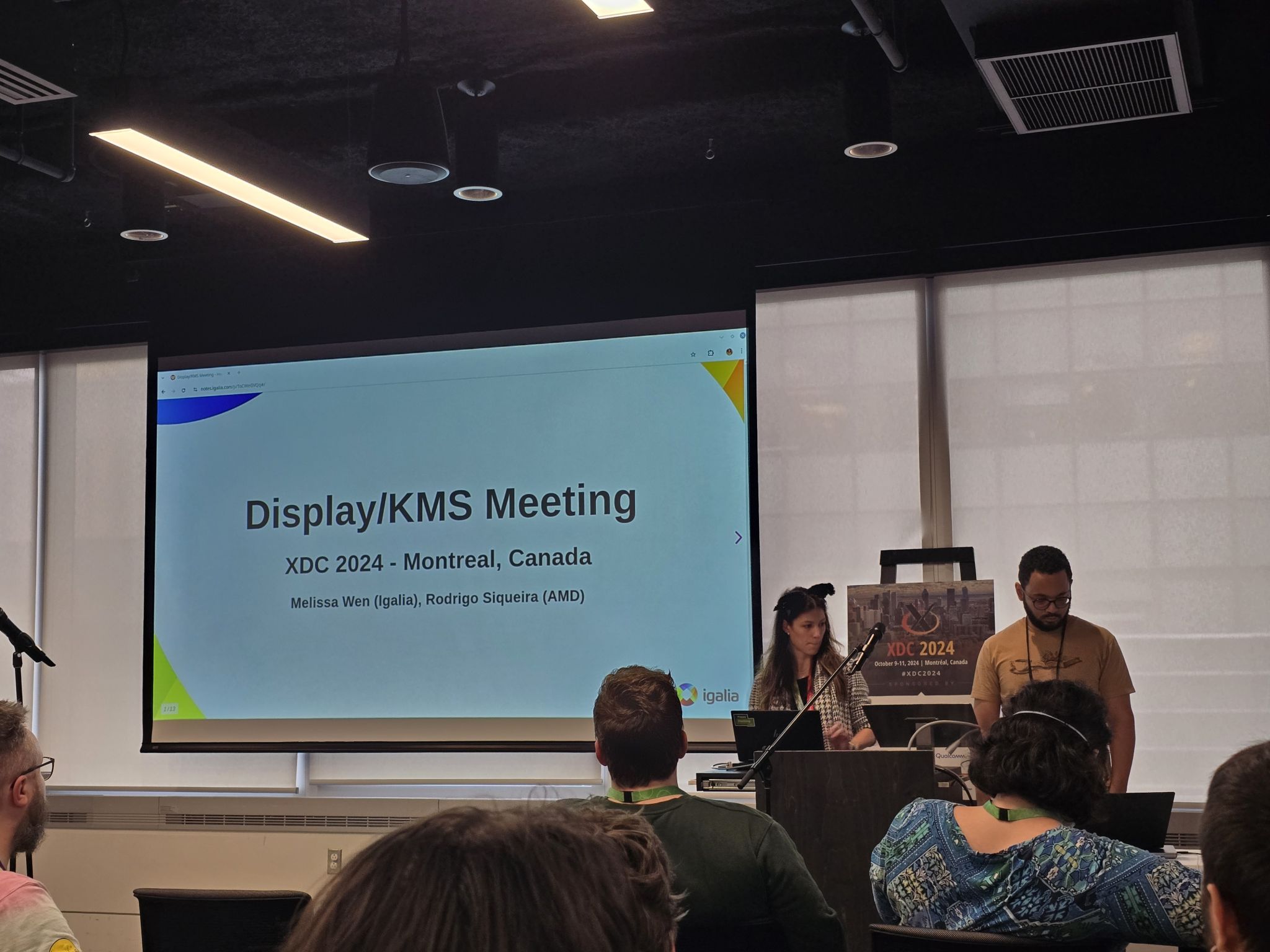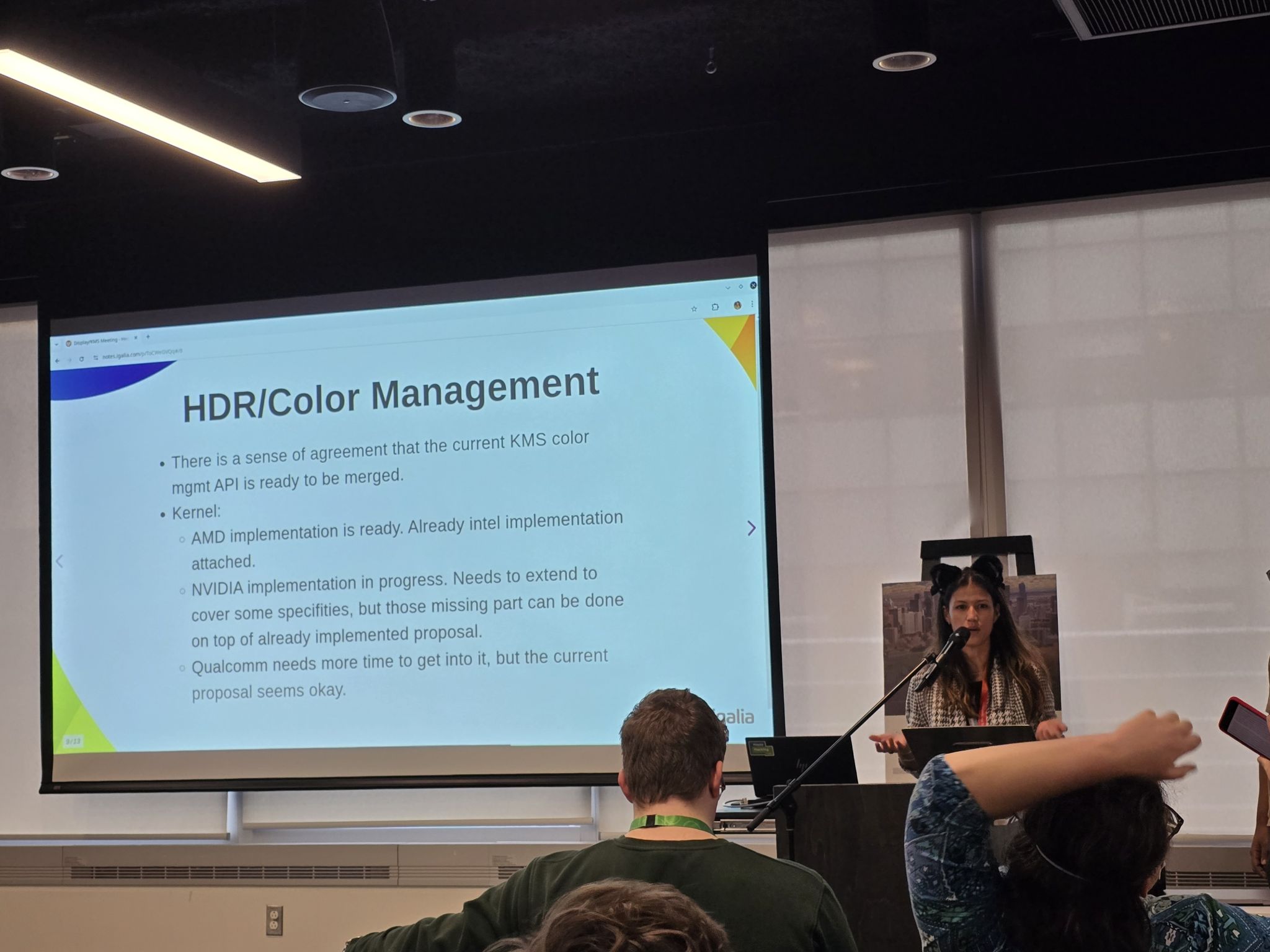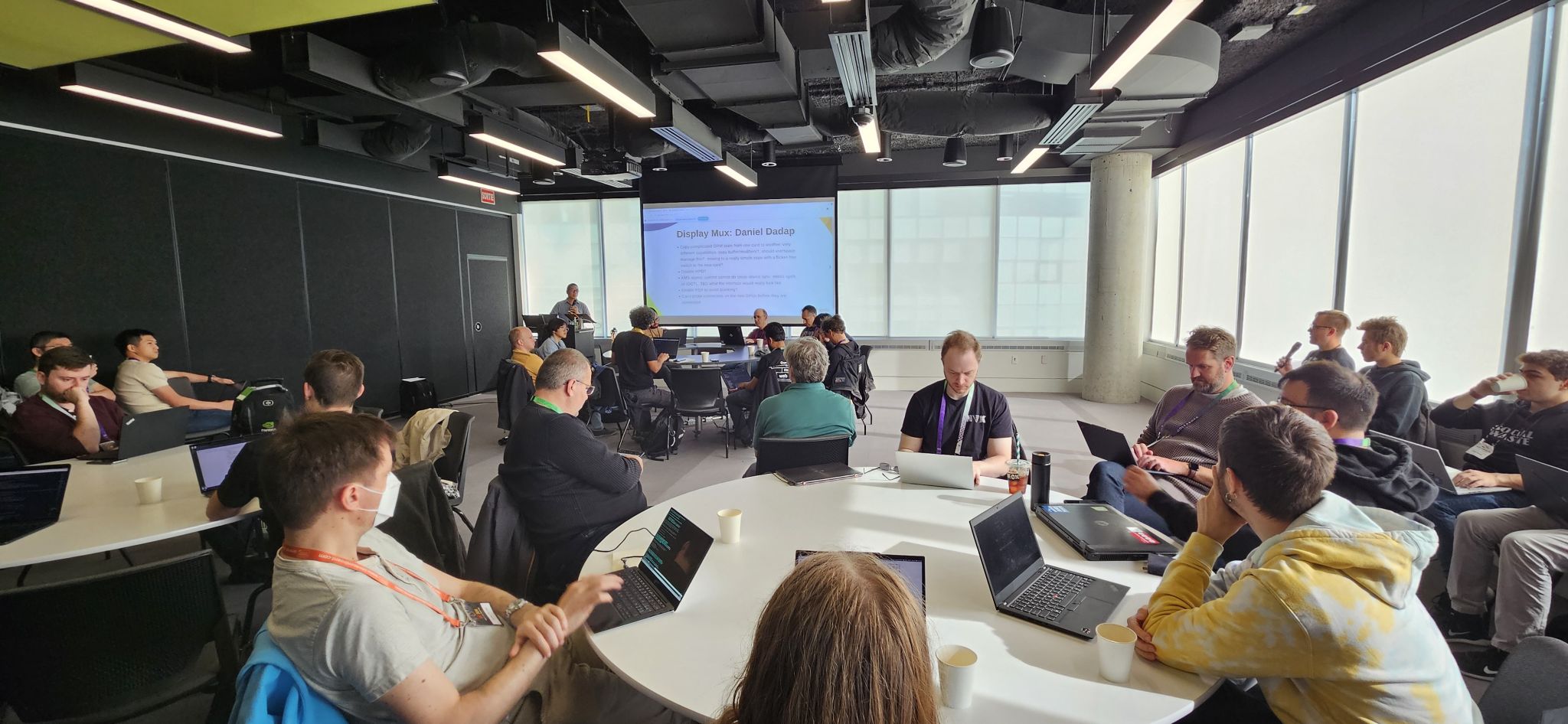XDC 2024 in Montreal was another fantastic gathering for the Linux Graphics community. It was again a great time to immerse in the world of graphics development, engage in stimulating conversations, and learn from inspiring developers.
Many Igalia colleagues and I participated in the conference again, delivering multiple talks about our work on the Linux Graphics stack and also organizing the Display/KMS meeting. This blog post is a detailed report on the Display/KMS meeting held during this XDC edition.
Short on Time?
- Catch the lightning talk summarizing the meeting here (you can even speed up 2x):
- For a quick written summary, scroll down to the TL;DR section.
TL;DR
This meeting took 3 hours and tackled a variety of topics related to DRM/KMS (Linux/DRM Kernel Modesetting):
- Sharing Drivers Between V4L2 and KMS: Brainstorming solutions for using a single driver for devices used in both camera capture and display pipelines.
- Real-Time Scheduling: Addressing issues with non-blocking page flips encountering sigkills under real-time scheduling.
- HDR/Color Management: Agreement on merging the current proposal, with NVIDIA implementing its special cases on VKMS and adding missing parts on top of Harry Wentland’s (AMD) changes.
- Display Mux: Collaborative design discussions focusing on compositor control and cross-sync considerations.
- Better Commit Failure Feedback: Exploring ways to equip compositors with more detailed information for failure analysis.
Bringing together Linux display developers in the XDC 2024
While I didn’t present a talk this year, I co-organized a Display/KMS meeting (with Rodrigo Siqueira of AMD) to build upon the momentum from the 2024 Linux Display Next hackfest. The meeting was attended by around 30 people in person and 4 remote participants.
Speakers: Melissa Wen (Igalia) and Rodrigo Siqueira (AMD)
Link: https://indico.freedesktop.org/event/6/contributions/383/
Topics: Similar to the hackfest, the meeting agenda was built over the first two days of the conference and mixed talks follow-up with new ideas and ongoing community efforts.
The final agenda covered five topics in the scheduled order:
- How to share drivers between V4L2 and DRM for bridge-like components (new topic);
- Real-time Scheduling (problems encountered after the Display Next hackfest);
- HDR/Color Management (ofc);
- Display Mux (from Display hackfest and XDC 2024 talk, bringing AMD and NVIDIA together);
- (Better) Commit Failure Feedback (continuing the last minute topic of the Display Next hackfest).
Unpacking the Topics
Similar to the hackfest, the meeting agenda evolved over the conference. During the 3 hours of meeting, I coordinated the room and discussion rounds, and Rodrigo Siqueira took notes and also contacted key developers to provide a detailed report of the many topics discussed.
From his notes, let’s dive into the key discussions!
How to share drivers between V4L2 and KMS for bridge-like components.
Led by Laurent Pinchart, we delved into the challenge of creating a unified driver for hardware devices (like scalers) that are used in both camera capture pipelines and display pipelines.
- Problem Statement: How can we design a single kernel driver to handle devices that serve dual purposes in both V4L2 and DRM subsystems?
- Potential Solutions:
- Multiple Compatible Strings: We could assign different compatible strings to the device tree node based on its usage in either the camera or display pipeline. However, this approach might raise concerns from device tree maintainers as it could be seen as a layer violation.
- Separate Abstractions: A single driver could expose the device to both DRM and V4L2 through separate abstractions: drm-bridge for DRM and V4L2 subdev for video. While simple, this approach requires maintaining two different abstractions for the same underlying device.
- Unified Kernel Abstraction: We could create a new, unified kernel abstraction that combines the best aspects of drm-bridge and V4L2 subdev. This approach offers a more elegant solution but requires significant design effort and potential migration challenges for existing hardware.
Real-Time Scheduling Challenges
We have discussed real-time scheduling during this year Linux Display Next hackfest and, during the XDC 2024, Jonas Adahl brought up issues uncovered while progressing on this front.
- Context: Non-blocking page-flips can, on rare occasions, take a long time and, for that reason, get a sigkill if the thread doing the atomic commit is a real-time schedule.
- Action items:
- Explore alternative backtraces during the busy wait (e.g., ftrace).
- Investigate the maximum thread time in busy wait to reproduce issues faced by compositors. Tools like RTKit (mutter) can be used for better control (Michel Dänzer can help with this setup).
HDR/Color Management
This is a well-known topic with ongoing effort on all layers of the Linux Display stack and has been discussed online and in-person in conferences and meetings over the last years.
Here’s a breakdown of the key points raised at this meeting:
- Talk: Color operations for Linux color pipeline on AMD devices: In the previous day, Alex Hung (AMD) presented the implementation of this API on AMD display driver.
- NVIDIA Integration: While they agree with the overall proposal, NVIDIA needs to add some missing parts. Importantly, they will implement these on top of Harry Wentland’s (AMD) proposal. Their specific requirements will be implemented on VKMS (Virtual Kernel Mode Setting driver) for further discussion. This VKMS implementation can benefit compositor developers by providing insights into NVIDIA’s specific needs.
- Other vendors: There is a version of the KMS API applied on Intel color pipeline. Apart from that, other vendors appear to be comfortable with the current proposal but lacks the bandwidth to implement it right now.
- Upstream Patches: The relevant upstream patches were can be found here. [As humorously notes, this series is eagerly awaiting your “Acked-by” (approval)]
- Compositor Side: The compositor developers have also made significant
progress.
- KDE has already implemented and validated the API through an experimental implementation in Kwin.
- Gamescope currently uses a driver-specific implementation but has a draft that utilizes the generic version. However, some work is still required to fully transition away from the driver-specific approach. AP: work on porting gamescope to KMS generic API
- Weston has also begun exploring implementation, and we might see something from them by the end of the year.
- Kernel and Testing: The kernel API proposal is well-refined and meets the DRM subsystem requirements. Thanks to Harry Wentland effort, we already have the API attached to two hardware vendors and IGT tests, and, thanks to Xaver Hugl, a compositor implementation in place.
Finally, there was a strong sense of agreement that the current proposal for HDR/Color Management is ready to be merged. In simpler terms, everything seems to be working well on the technical side - all signs point to merging and “shipping” the DRM/KMS plane color management API!
Display Mux
During the meeting, Daniel Dadap led a brainstorming session on the design of the display mux switching sequence, in which the compositor would arm the switch via sysfs, then send a modeset to the outgoing driver, followed by a modeset to the incoming driver.
- Context:
- During this year Linux Display Next hackfest, Mario Limonciello (AMD) introduced the topic and led a discussion on Display Mux.
- Daniel Dadap (NVIDIA) retook this discussion with the XDC 2024 talk: Dynamic Switching of Display Muxes on Hybrid GPU Systems.
- Key Considerations:
- HPD Handling: There was a general consensus that disabling HPD can be part of the sequence for internal panels and we don’t need to focus on it here.
- Cross-Sync: Ensuring synchronization between the compositor and the drivers is crucial. The compositor should act as the “drm-master” to coordinate the entire sequence, but how can this be ensured?
- Future-Proofing: The design should not assume the presence of a mux. In future scenarios, direct sharing over DP might be possible.
- Action points:
- Sharing DP AUX: Explore the idea of sharing DP AUX and its implications.
- Backlight: The backlight definition represents a problem in the mux switch context, so we should explore some of the current specs available for that.
Towards Better Commit Failure Feedback
In the last part of the meeting, Xaver Hugl asked for better commit failure feedback.
- Problem description: Compositors currently face challenges in collecting detailed information from the kernel about commit failures. This lack of granular data hinders their ability to understand and address the root causes of these failures.
To address this issue, we discussed several potential improvements:
- Direct Kernel Log Access: One idea is to directly load relevant kernel logs into the compositor. This would provide more detailed information about the failure and potentially aid in debugging.
- Finer-Grained Failure Reporting: We also explored the possibility of separating atomic failures into more specific categories. Not all failures are critical, and understanding the nature of the failure can help compositors take appropriate action.
- Enhanced Logging: Currently, the dmesg log doesn’t provide enough information for user-space validation. Raising the log level to capture more detailed information during failures could be a viable solution.
By implementing these improvements, we aim to equip compositors with the necessary tools to better understand and resolve commit failures, leading to a more robust and stable display system.
A Big Thank You!
Huge thanks to Rodrigo Siqueira for these detailed meeting notes. Also, Laurent Pinchart, Jonas Adahl, Daniel Dadap, Xaver Hugl, and Harry Wentland for bringing up interesting topics and leading discussions. Finally, thanks to all the participants who enriched the discussions with their experience, ideas, and inputs, especially Alex Goins, Antonino Maniscalco, Austin Shafer, Daniel Stone, Demi Obenour, Jessica Zhang, Joan Torres, Leo Li, Liviu Dudau, Mario Limonciello, Michel Dänzer, Rob Clark, Simon Ser and Teddy Li.
This collaborative effort will undoubtedly contribute to the continued development of the Linux display stack.
Stay tuned for future updates!




